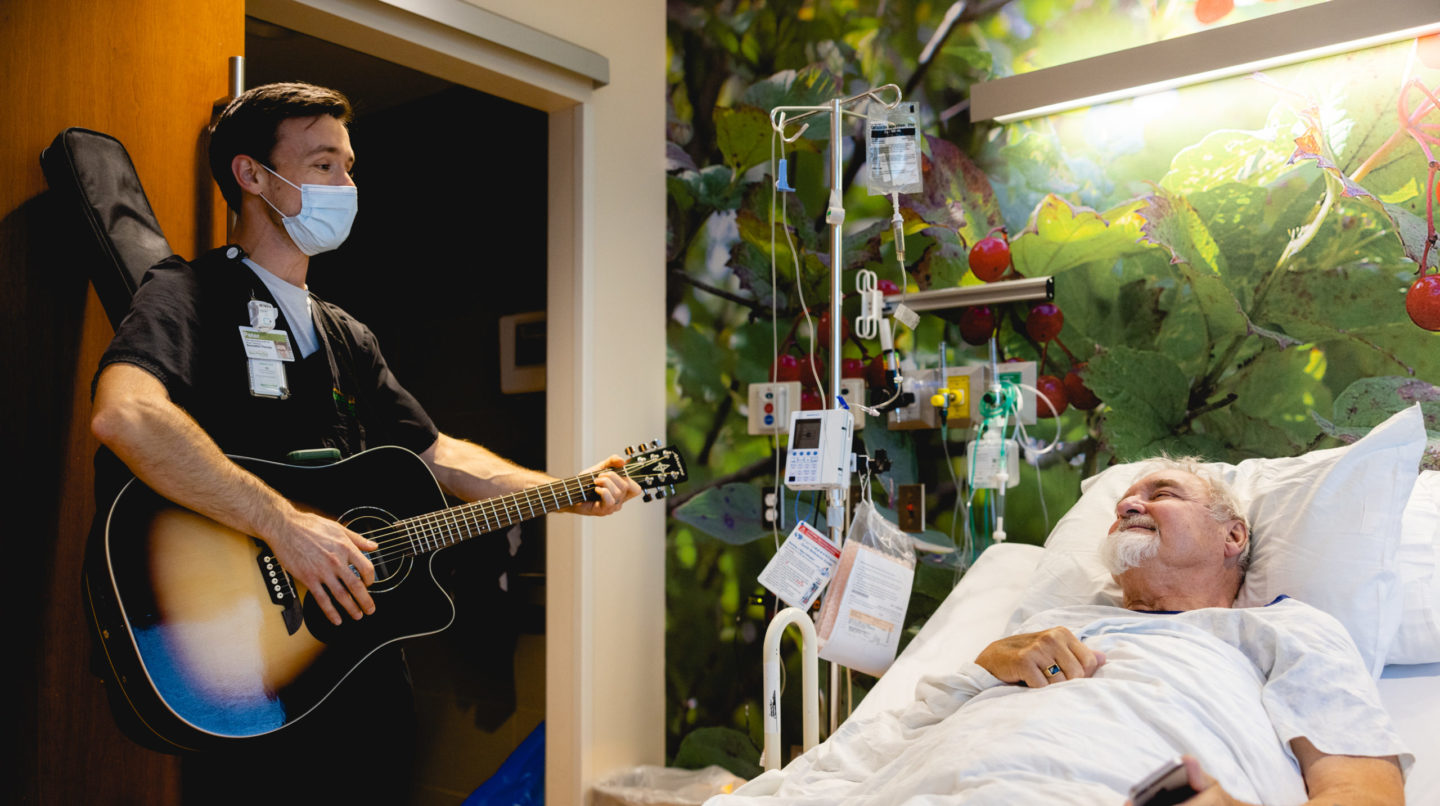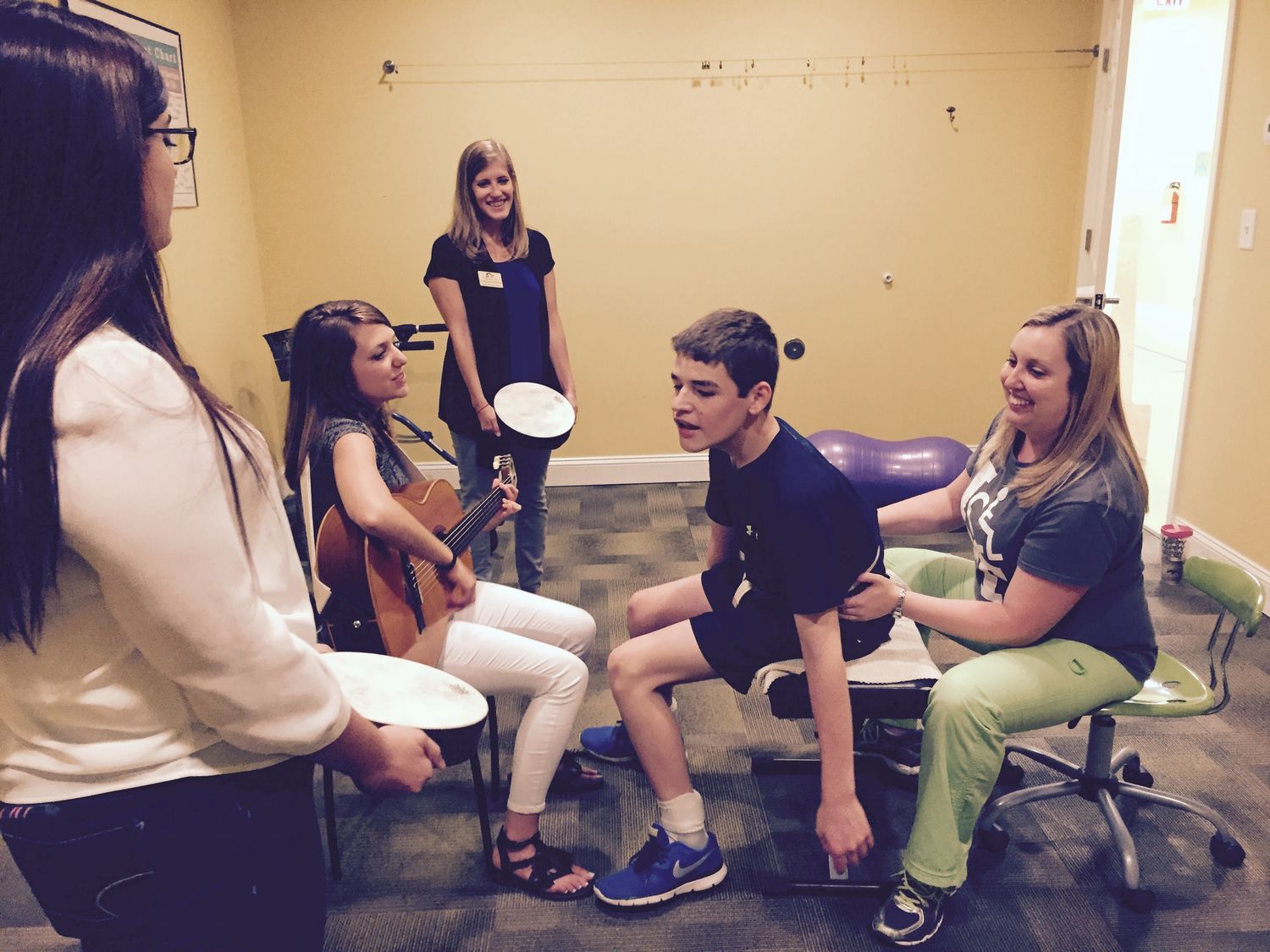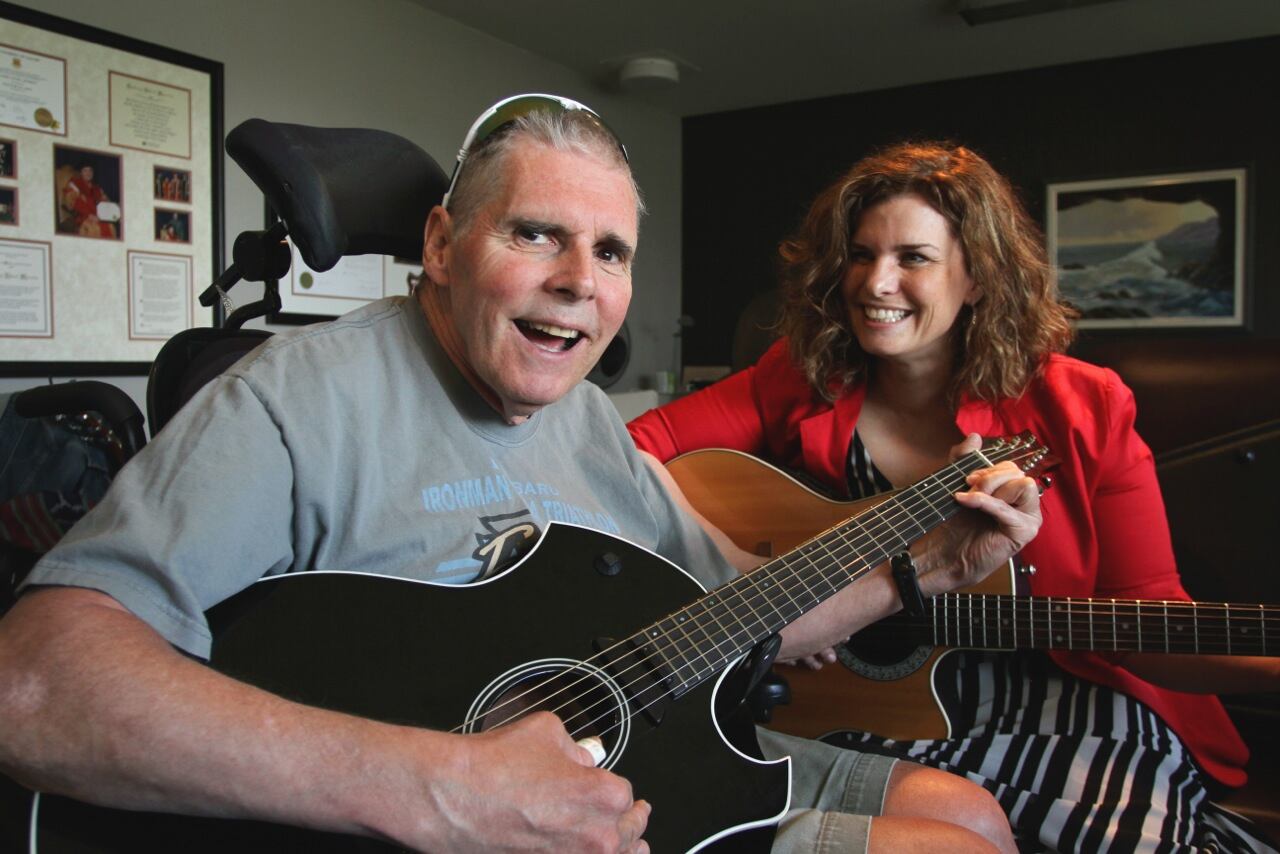Home>Events & Info>Music Therapy>How Can Music Therapy Help A Hospital Patient?


Music Therapy
How Can Music Therapy Help A Hospital Patient?
Published: February 2, 2024
Discover the healing power of music therapy for hospital patients. Learn how music can reduce stress, promote relaxation, and enhance overall well-being.
(Many of the links in this article redirect to a specific reviewed product. Your purchase of these products through affiliate links helps to generate commission for AudioLover.com, at no extra cost. Learn more)
Table of Contents
- Introduction
- Benefits of Music Therapy in Hospital Settings
- Reducing Pain and Anxiety
- Stress Reduction and Relaxation
- Improved Emotional Well-being
- Enhancing Cognitive Abilities
- Enhancing Physical Rehabilitation
- Music Therapy Techniques in Hospital Settings
- Live Music Performance
- Music-Assisted Relaxation and Guided Imagery
- Songwriting and Lyric Analysis
- Group Music Therapy Sessions
- Music Listening
- Integration of Music Therapy into Hospital Care
- Collaboration with Healthcare Professionals
- Individualized Treatment Plans
- Music Therapy and Palliative Care
- Conclusion
Introduction
Music has always held a special place in human culture, with the power to evoke emotions, inspire creativity, and bring people together. But its influence extends beyond mere entertainment. In recent years, the field of music therapy has gained recognition for its ability to promote healing and well-being in various contexts, including hospitals.
Music therapy is an evidence-based practice that utilizes music interventions to address physical, emotional, cognitive, and social needs of individuals. It is conducted by trained music therapists who design and implement customized treatment plans for patients. In a hospital setting, music therapy can play a crucial role in improving the overall experience and outcomes for patients.
Music therapy has a range of benefits, including reducing pain and anxiety, promoting relaxation, improving emotional well-being, enhancing cognitive abilities, and supporting physical rehabilitation. By incorporating music into healthcare settings, hospitals are capitalizing on the therapeutic potential of music to aid in the healing process and enhance quality of life for patients.
This article will explore the various ways in which music therapy can help hospital patients. We will delve into the benefits it offers, the techniques employed by music therapists, and the integration of music therapy into hospital care. By understanding the impact of music therapy, healthcare professionals can better appreciate its value and make informed decisions regarding its inclusion in patient treatment plans.
Benefits of Music Therapy in Hospital Settings
The use of music therapy in hospital settings has been shown to provide a range of benefits for patients, both physically and emotionally. The following are some of the key advantages:
- Reducing Pain and Anxiety: Music therapy has been found to be effective in reducing levels of pain and anxiety in hospital patients. Listening to soothing music or engaging in musical activities can help distract patients from their discomfort, allowing them to relax and experience a sense of relief.
- Stress Reduction and Relaxation: Hospitals can be a source of stress and tension for patients, particularly those undergoing treatments or procedures. Music therapy offers a means of relaxation and stress reduction, creating a calming environment that can alleviate feelings of anxiety and promote a sense of well-being.
- Improved Emotional Well-being: The emotional well-being of patients is equally important as their physical health. Music therapy provides a creative outlet for expressing emotions and processing difficult experiences. It can uplift spirits, boost mood, and foster a sense of hope and positivity.
- Enhancing Cognitive Abilities: Music has a powerful impact on the brain, stimulating various cognitive functions. In hospital settings, music therapy can help improve memory, attention, and problem-solving skills. It can also promote cognitive development in children and aid in the rehabilitation of patients with neurological conditions.
- Enhancing Physical Rehabilitation: Music therapy can be an effective tool in physical rehabilitation. It can motivate patients to engage in movement exercises and enhance motor skills. Music with rhythmic patterns can serve as a guide for coordinated movements, helping patients regain strength and mobility.
These benefits not only improve the overall well-being of patients but can also contribute to a more efficient and successful healing process. By harnessing the power of music, hospitals can create a supportive environment that promotes recovery and improves the patient experience.
Reducing Pain and Anxiety
Pain and anxiety are common experiences for many hospital patients, whether they are undergoing medical procedures, recovering from surgery, or managing chronic conditions. Music therapy has shown remarkable effectiveness in reducing pain and anxiety levels, providing patients with much-needed comfort and relief.
When patients listen to soothing music or engage in musical activities, their attention becomes diverted from their discomfort, shifting their focus to the harmonies, rhythms, and melodies. This distraction can help alleviate the perception of pain and reduce anxiety levels, allowing patients to experience a greater sense of calmness and relaxation.
Music therapy also has the ability to stimulate the release of endorphins, the body’s natural painkillers. These endorphins can help mitigate pain sensations and improve overall well-being. Additionally, music therapy promotes the activation of the body’s relaxation response, reducing muscle tension and promoting a general sense of well-being.
Moreover, the emotional and psychological impact of music cannot be underestimated. Music has the power to evoke deep emotions, and music therapy allows patients to express their emotions more freely and safely. This emotional release can provide psychological relief and contribute to the overall reduction of pain and anxiety.
In a study published in the Journal of Advanced Nursing, researchers found that patients who received music therapy reported significantly lower levels of pain compared to those who did not receive the intervention. Similarly, studies have shown that music therapy can effectively reduce anxiety levels in patients awaiting surgery or medical procedures.
Music therapy interventions can be tailored to each patient’s individual preferences and needs. For instance, some patients may find comfort in classical music, while others may prefer soft instrumental melodies or even their favorite songs. Music therapists work closely with patients to identify their musical preferences and develop personalized playlists or musical experiences that cater to their unique needs.
By incorporating music therapy into hospital settings, healthcare professionals can provide patients with a non-pharmacological approach to managing pain and anxiety. It offers a safe and accessible method for promoting relaxation and comfort, ultimately improving the overall well-being of patients.
Stress Reduction and Relaxation
Hospitals can be inherently stressful environments for patients, filled with unfamiliar surroundings, medical procedures, and an underlying sense of uncertainty. Music therapy offers a powerful tool for stress reduction and relaxation, creating a calming and soothing atmosphere that can alleviate anxiety and promote a sense of well-being.
Listening to relaxing music has been shown to activate the parasympathetic nervous system, which is responsible for the body’s relaxation response. This response leads to a reduction in heart rate, blood pressure, and muscle tension, promoting a state of relaxation. By incorporating soothing melodies, gentle rhythms, and harmonious sounds into the hospital environment, music therapy can help patients find solace and tranquility amidst the chaos.
Many hospitals have dedicated relaxation rooms or designated areas where patients can have access to music therapy interventions. In these spaces, patients can enjoy quiet and comfortable settings while immersing themselves in calming music. Music-assisted relaxation sessions often involve deep breathing exercises, guided imagery, and progressive muscle relaxation techniques. These help patients further unwind and let go of stress, allowing them to experience a deeper state of relaxation.
Moreover, music therapy provides a form of emotional support for patients. It allows them to express their emotions and find solace in the music that resonates with them. Whether it’s a melancholic melody that allows for catharsis or an uplifting tune that brings joy, music therapy serves as an outlet for processing emotions and promoting emotional well-being.
Research has shown that music therapy interventions can lead to significant reductions in stress and anxiety levels among hospital patients. A study published in the Journal of Music Therapy found that adult patients undergoing chemotherapy reported reduced stress and improved mood after music therapy sessions. Another study published in Psycho-Oncology demonstrated that cancer patients who received music therapy experienced lower levels of anxiety and enhanced relaxation.
Integrating music therapy into hospitals not only provides a means of stress reduction and relaxation for patients but also creates a more nurturing and supportive environment. By incorporating music into the healthcare setting, hospitals have the opportunity to alleviate stress, enhance patient comfort, and contribute to a positive healing experience.
Improved Emotional Well-being
The emotional well-being of patients is of utmost importance in the hospital setting, as it plays a significant role in their overall healing process. Music therapy has been shown to have a profound impact on emotional well-being, providing patients with a creative outlet for expression and promoting a sense of comfort and hope.
Music has the ability to evoke a wide range of emotions, from joy and excitement to sadness and nostalgia. In music therapy, patients are encouraged to explore these emotions through various musical activities, such as playing instruments, singing, or engaging in songwriting. By giving voice to their emotions in a safe and supportive environment, patients can experience a release and find solace in the music.
Music therapy also allows patients to process their experiences and cope with the challenges they may be facing. Through songwriting or lyric analysis, patients can express their thoughts and feelings in a meaningful way, gaining insights and finding comfort in the process. This form of creative expression can promote self-discovery, foster resilience, and provide a sense of empowerment.
When patients engage in music therapy, they often experience positive emotional shifts. The mood-lifting qualities of music can bring moments of joy and happiness, even in the midst of difficult circumstances. The ability to experience positive emotions can be particularly valuable for patients who may be dealing with chronic pain, long hospital stays, or life-altering diagnoses.
Research has demonstrated the positive impact of music therapy on emotional well-being. A study published in the Journal of Medical Internet Research found that music therapy interventions significantly reduced symptoms of depression and anxiety in patients with chronic pain. Another study published in the Journal of Pain and Symptom Management showed that music therapy improved mood and reduced distress in patients receiving palliative care.
By incorporating music therapy into hospitals, healthcare professionals can create a nurturing and supportive environment that addresses the emotional needs of patients. It offers a means of emotional expression, comfort, and hope, enhancing the overall well-being and quality of life for patients during their hospital stay.
Enhancing Cognitive Abilities
Music has a powerful impact on the brain, stimulating various cognitive functions and enhancing cognitive abilities. In the hospital setting, music therapy can play a valuable role in improving cognitive abilities, such as memory, attention, problem-solving, and language skills.
Music therapy interventions that involve active engagement, such as playing instruments, singing, or rhythmic exercises, require patients to use multiple areas of the brain simultaneously. This multisensory stimulation can enhance neural connections, promoting brain plasticity and facilitating cognitive improvements.
One of the notable cognitive benefits of music therapy is its impact on memory. Music has a unique ability to evoke memories and emotions associated with specific times and experiences. This phenomenon is particularly evident in patients with dementia or other memory-related conditions. Music therapy can help evoke memories, stimulate cognitive processes, and improve recall ability.
Furthermore, music therapy can enhance attention and focus. The rhythmic patterns and melodic structures of music can help regulate attention and improve concentration. In hospital settings, where patients may be surrounded by distractions or experience difficulty focusing due to pain or medications, music therapy can provide a structured and engaging activity that promotes sustained attention.
Problem-solving skills can also be improved through music therapy. Engaging in improvisation or composition exercises requires patients to think creatively and make decisions in real-time. Navigating musical structures, harmonies, and melodies challenges the brain’s problem-solving abilities and promotes cognitive flexibility.
Language and communication skills can also be positively influenced by music therapy. Singing, chanting, and engaging in rhythmic exercises can improve speech production, articulation, and vocalization. Music therapy interventions that involve songwriting or lyric analysis can also support expressive and receptive language skills.
Research has demonstrated the cognitive benefits of music therapy in various populations. A study published in the Journal of Music Therapy found that children with autism spectrum disorder who received music therapy showed improvements in their verbal and non-verbal communication skills. Another study published in the Journal of the American Geriatrics Society showed that music therapy improved cognitive function and memory in older adults with dementia.
By incorporating music therapy into hospitals, healthcare professionals have the opportunity to harness the cognitive benefits of music. This can not only enhance patients’ cognitive abilities but also contribute to their overall well-being and quality of life.
Enhancing Physical Rehabilitation
Music therapy can be a valuable tool in physical rehabilitation, helping patients regain strength, improve motor skills, and enhance overall physical well-being. Through the strategic use of music, rhythm, and movement, music therapy facilitates the rehabilitation process in the hospital setting.
One of the primary ways that music therapy supports physical rehabilitation is by motivating patients to engage in movement exercises. Music has the power to evoke emotions and create a positive and enjoyable environment. By incorporating music into physical therapy sessions, patients are more likely to feel motivated, energized, and willing to participate in their rehabilitation activities.
Music therapy utilizes rhythmic patterns and beats to guide and facilitate movement. Patients can synchronize their movements with the music, enhancing coordination, balance, and motor control. This synchronized movement can have a significant impact on physical rehabilitation, particularly for individuals who have experienced injuries, strokes, or neurological conditions.
Moreover, music therapy can help patients improve their range of motion and muscle strength. By incorporating specific exercises and movements to the rhythm of the music, patients can target specific muscle groups and gradually increase their physical capabilities. This engagement promotes repetition, consistency, and gradual progress in their rehabilitation journey.
Additionally, music therapy can stimulate the brain’s motor regions, promoting neuroplasticity and aiding in the rewiring and recovery of neural pathways. This can be particularly beneficial for patients who have experienced strokes or have conditions that affect movement and coordination.
Research has shown the efficacy of music therapy in enhancing physical rehabilitation. A study published in Frontiers in Human Neuroscience demonstrated that stroke patients who received music-supported therapy showed improvements in their arm function and motor skills compared to those who received standard therapy. Another study published in the Journal of Music Therapy found that music-assisted gait training improved walking abilities in patients with Parkinson’s disease.
By integrating music therapy into hospitals, healthcare professionals can optimize physical rehabilitation programs and enhance patients’ overall progress and outcomes. Music therapy provides a motivating and enjoyable approach to rehabilitation, encouraging patients to actively engage in their recovery journey and regain physical mobility.
Music Therapy Techniques in Hospital Settings
In hospital settings, music therapy encompasses a variety of techniques that are tailored to meet the unique needs of each patient. Music therapists utilize a range of interventions to create positive therapeutic experiences and promote healing and well-being. The following are some of the techniques commonly used in music therapy within hospital settings:
- Live Music Performance: Music therapists often incorporate live music performances as a therapeutic intervention. Whether solo or in a group setting, live music can uplift spirits, create a sense of connection, and promote emotional expression. These performances may involve playing instruments, singing, or both, depending on the preferences and abilities of the patients.
- Music-Assisted Relaxation and Guided Imagery: Guided imagery is a technique where patients are encouraged to imagine themselves in a peaceful and calming environment while listening to soothing music. This technique is particularly helpful in reducing stress, promoting relaxation, and enhancing emotional well-being. Music therapists may also use relaxation techniques, such as progressive muscle relaxation, alongside music-assisted relaxation practices.
- Songwriting and Lyric Analysis: Songwriting allows patients to express their thoughts, emotions, and experiences through creating original lyrics and melodies. It provides a therapeutic outlet for personal expression and can help patients process challenging emotions or experiences. Music therapists may also engage in lyric analysis, exploring the meaning and symbolism within existing songs to facilitate reflection and discussion.
- Group Music Therapy Sessions: Group sessions allow patients to come together and engage in musical activities as a collective. This fosters a sense of community, support, and camaraderie among patients. Group music therapy sessions may include drum circles, singing groups, or instrumental ensembles. These activities promote social interaction, communication, and a sense of belonging.
- Music Listening: Simply listening to music can be a powerful therapeutic intervention. Music therapists carefully select music tailored to each patient’s preferences and therapeutic goals. Listening to uplifting or calming music can evoke emotion, promote relaxation, and serve as a source of comfort and solace for patients.
These techniques are implemented by trained music therapists who design personalized treatment plans for each patient. They take into consideration the patient’s preferences, capabilities, and therapeutic goals. The interventions may be conducted individually or in group settings, depending on the needs and dynamics of the hospital environment.
Music therapy techniques are flexible and adaptable, allowing for creativity and individualized approaches. By incorporating these techniques into hospital care, healthcare professionals can provide holistic and patient-centered treatment, addressing not only the physical needs but also the emotional, cognitive, and social well-being of patients.
Live Music Performance
Live music performance is a powerful and engaging technique used in music therapy within hospital settings. Music therapists, often skilled musicians themselves, incorporate live performances to create meaningful therapeutic experiences for patients.
Whether performed individually or in a group setting, live music performances have the ability to uplift spirits, create a sense of connection, and evoke deep emotions. The presence of a live musician can create a unique and personal experience for patients, fostering a sense of engagement and interaction.
During live music performances, music therapists may play various instruments, sing, or combine both elements. The selection of music is carefully tailored to meet the individual preferences and therapeutic goals of the patients. The therapist may perform familiar songs, traditional melodies, or even create improvised music to suit the needs of each patient’s unique situation.
The experience of live music can elicit joy, nostalgia, relaxation, or catharsis, depending on the chosen music and the emotional connection the patient has with it. Patients often respond with enthusiastic participation, whether through singing along, clapping, swaying, or even playing instruments alongside the therapist.
Live music performances have the power to create a healing atmosphere, transforming the hospital environment into a more nurturing and uplifting space. The melodies and rhythms can provide a welcome distraction from illness, pain, or anxiety, allowing patients to experience moments of respite and pleasure.
Furthermore, live music performances can promote social interaction and foster a sense of community among patients. Group performances allow patients to come together, share in the musical experience, and create connections with one another. This sense of togetherness can combat feelings of isolation and provide a supportive environment for emotional expression.
Research has shown the positive impact of live music performances in hospital settings. Numerous studies have demonstrated the benefits of live music for reducing levels of pain, anxiety, and stress among patients. Live music interventions have also been found to enhance overall patient satisfaction and improve mood and emotional well-being.
By incorporating live music performances into music therapy sessions, healthcare professionals can tap into the transformative power of music. These performances can create a sense of connection, provide emotional release, and contribute to the overall healing and well-being of patients during their hospital stay.
Music-Assisted Relaxation and Guided Imagery
Music-assisted relaxation and guided imagery are powerful techniques utilized in music therapy within hospital settings to promote relaxation, reduce stress, and enhance overall well-being. These interventions combine the therapeutic elements of music with guided visualization exercises to create a soothing and calming experience for patients.
During music-assisted relaxation sessions, patients are encouraged to find a comfortable position and listen to relaxing music chosen specifically for its calming qualities. As the music plays, the therapist provides verbal guidance, leading patients through a series of deep breathing exercises, progressive muscle relaxation techniques, and guided imagery journeys.
Guided imagery involves guiding the patient’s imagination to create mental images of calming and peaceful environments. The music serves as a backdrop, enhancing the sensory experience and deepening the relaxation response. Patients may be guided to visualize themselves in serene natural settings, such as a beach or a forest, or to imagine themselves engaging in activities that bring them joy and tranquility.
The combination of music and guided imagery stimulates the relaxation response in the body, activating the parasympathetic nervous system. This leads to a decrease in heart rate, blood pressure, and muscle tension, promoting a deep sense of relaxation and calmness.
Music-assisted relaxation and guided imagery are particularly effective in reducing stress and anxiety levels. The soothing music, combined with the therapist’s supportive guidance, helps patients shift their focus away from their worries and concerns, allowing them to enter a state of deep relaxation.
These interventions also encourage mindfulness and present moment awareness. By focusing on the music, the breath, and the guided imagery, patients are encouraged to be fully present in the moment, letting go of past thoughts or future concerns. This mindfulness practice can help patients cultivate a sense of inner peace and serenity.
Research has demonstrated the positive impact of music-assisted relaxation and guided imagery in hospital settings. Studies have shown significant reductions in anxiety levels among patients undergoing medical procedures or awaiting surgery when these interventions are utilized. Additionally, music-assisted relaxation has been found to enhance sleep quality, improve mood, and promote overall well-being.
By incorporating music-assisted relaxation and guided imagery into music therapy sessions, healthcare professionals provide patients with a powerful tool for relaxation and stress reduction. These techniques promote emotional well-being, alleviate anxiety, and enhance the overall healing experience during a hospital stay.
Songwriting and Lyric Analysis
Songwriting and lyric analysis are impactful techniques used in music therapy within hospital settings to promote self-expression, emotional processing, and personal growth. These interventions allow patients to engage in the creative process, empowering them to communicate their thoughts and emotions through the medium of music and lyrics.
Songwriting involves the creation of original songs, where patients have the opportunity to write lyrics and melodies that reflect their personal experiences, thoughts, and emotions. Music therapists facilitate this process by providing guidance, support, and musical accompaniment as needed. They help patients explore different genres, musical styles, and song structures to find the best means of self-expression.
Through the act of songwriting, patients can develop a sense of agency and empowerment. It provides an outlet for creativity, allowing them to express themselves in a unique and personal way. The process of crafting lyrics can be cathartic, enabling patients to process and make meaning out of their experiences or emotions.
Lyric analysis is another powerful technique used in music therapy. During these sessions, patients explore the lyrics of pre-existing songs, examining their meaning, symbolism, and emotional content. This exploration allows patients to connect with the emotions expressed in the songs and relate them to their own experiences.
Through lyric analysis, patients gain insights into their own thoughts and feelings. They may resonate with certain lyrics or find comfort in knowing that others have felt similar emotions. This process promotes self-reflection, emotional awareness, and the development of coping strategies.
Both songwriting and lyric analysis can be particularly valuable in helping patients process difficult experiences, such as trauma, grief, or life-altering diagnoses. These techniques provide a safe and supportive space for patients to unpack their emotions and find solace in the act of creating or exploring music and lyrics.
Research has shown the therapeutic benefits of songwriting and lyric analysis in hospital settings. Studies have demonstrated improvements in emotional well-being, self-esteem, and coping mechanisms among patients who engage in these interventions. Additionally, songwriting and lyric analysis have been found to enhance communication skills and promote emotional release.
By incorporating songwriting and lyric analysis into music therapy sessions, healthcare professionals provide patients with a powerful means of self-expression and emotional processing. These techniques offer a unique outlet for creative expression, fostering personal growth, and facilitating the healing process during a hospital stay.
Group Music Therapy Sessions
Group music therapy sessions are a dynamic and inclusive technique used in hospital settings to promote social interaction, communication, and mutual support among patients. These sessions provide a space for patients to come together, create music, and share in the therapeutic experience as a collective.
In group music therapy sessions, patients engage in musical activities such as drum circles, singing groups, or instrumental ensembles. These activities are designed to encourage collaboration, cooperation, and teamwork. Patients have the opportunity to play various instruments, sing together, and create harmonies, fostering a sense of unity and camaraderie.
Group sessions can create a supportive community where patients feel understood and accepted. The experience of making music together can be empowering, as patients realize they are part of something larger than themselves and can contribute to the collective creation of music and sound.
Music therapists facilitate group sessions by providing structure and guidance, setting goals, and creating a safe and inclusive environment for expression. The therapist encourages active participation and provides opportunities for patients to take turns leading or improvising within the group. This allows patients to explore their musical abilities, build confidence, and develop communication skills.
Group music therapy sessions have numerous benefits. They promote social interaction and cohesion, combating feelings of isolation and loneliness that can arise during a hospital stay. Patients can engage in meaningful conversations, build connections, and establish a sense of belonging within the group.
These sessions also provide opportunities for patients to enhance their communication skills. Through musical interaction, patients learn to listen actively, respond to each other’s cues, and communicate nonverbally. This can be particularly valuable for patients who may have difficulty expressing themselves verbally due to their condition or treatment.
Research has shown the positive impact of group music therapy sessions in hospital settings. Studies have demonstrated improvements in social skills, emotional well-being, and overall quality of life among patients who participate in group music therapy. Additionally, the experience of making music in a group setting has been found to reduce anxiety levels and improve mood.
By incorporating group music therapy sessions into hospital care, healthcare professionals provide patients with a unique opportunity for social connection and enrichment. These sessions foster a sense of community, promote communication skills, and contribute to the overall well-being and healing experience during a hospital stay.
Music Listening
Music listening is a powerful and accessible technique used in music therapy within hospital settings to promote relaxation, emotional well-being, and therapeutic benefits. Simply listening to music can have a profound impact on patients, providing comfort, inspiration, and solace during their hospital stay.
Music therapists carefully curate playlists that are tailored to meet the individual preferences and therapeutic goals of each patient. The chosen music may vary based on genres, artists, or specific songs that hold personal significance for the patient. By selecting music that resonates with the patient, music therapists create a unique and meaningful listening experience.
Music listening sessions provide patients with a dedicated space and time to immerse themselves in the sounds and melodies. Patients can listen to music using headphones or through speakers, depending on their preference and medical requirements. By creating an environment free from distractions, patients can fully engage with the music and be present in the listening experience.
Music listening evokes a wide range of emotions and can have a profound effect on mood and well-being. Upbeat and cheerful music can uplift spirits and bring moments of joy and positivity, while soft and soothing music can promote relaxation and tranquility. Patients often find solace in familiar melodies or discover new songs that resonate with their current emotional state.
Music listening offers a form of emotional support and connection. Patients may find comfort in knowing that others have experienced similar emotions and challenges, as portrayed through the lyrics and melodies of songs. Music can serve as a companion, providing a sense of reassurance and understanding during difficult times.
Research has shown the therapeutic benefits of music listening in hospital settings. Studies have demonstrated reductions in anxiety levels, improvements in mood, and increased levels of relaxation among patients who engage in music listening interventions. Additionally, music listening has been found to enhance pain management and promote a sense of control over one’s emotional well-being.
By incorporating music listening into music therapy sessions, healthcare professionals provide patients with a readily accessible and meaningful therapeutic experience. Whether it’s finding comfort in familiar tunes or discovering new music that resonates, music listening allows patients to find solace, enhance emotional well-being, and connect with the healing power of music during their hospital stay.
Integration of Music Therapy into Hospital Care
The integration of music therapy into hospital care involves incorporating music as a core component of patient treatment plans. By recognizing the therapeutic potential of music, healthcare professionals and institutions can optimize the well-being and outcomes of patients during their hospital stay.
Collaboration with healthcare professionals is essential for successful integration. Music therapists work alongside doctors, nurses, and other healthcare providers to identify patients who can benefit from music therapy and to coordinate the incorporation of music into their care. This collaboration ensures that music therapy aligns with the overall treatment goals and addresses specific patient needs.
Individualized treatment plans are developed to cater to each patient’s unique circumstances. Music therapists assess the patient’s medical condition, emotional state, and personal preferences to design interventions that are tailored and effective. By considering these factors, music therapy can be personalized to maximize its therapeutic impact.
The integration of music therapy is particularly relevant in palliative care. Music therapy can provide comfort, emotional support, and pain management for patients at the end of life. By collaborating with the palliative care team, music therapists can address the physical, emotional, and spiritual needs of patients, promoting dignity and quality of life.
Integrating music therapy into hospital care involves creating dedicated spaces and resources for music therapy sessions. This may include designated music therapy rooms equipped with various musical instruments, recording equipment, and a comfortable environment for patients to engage in therapeutic musical activities.
Training and professional development programs should be in place to ensure that music therapists are equipped with the necessary skills and knowledge to deliver high-quality care. Ongoing education and collaboration with professional organizations and networks help music therapists stay updated with the latest research and best practices in the field.
Evaluation and outcome measures are essential for assessing the effectiveness of music therapy interventions. Healthcare professionals and music therapists collaborate to monitor patient progress, collect data, and evaluate the impact of music therapy on patient outcomes. This information contributes to the ongoing improvement and integration of music therapy into hospital care.
Research has consistently shown the numerous benefits of integrating music therapy into hospital care. Studies have demonstrated reductions in pain, anxiety, and stress, improvements in mood and emotional well-being, enhanced communication, and increased patient satisfaction.
By integrating music therapy into hospital care, healthcare professionals can tap into the healing power of music to enhance patient well-being and quality of life. Music therapy provides a holistic and patient-centered approach, addressing emotional, physical, cognitive, and social needs. It fosters a supportive and nurturing environment that promotes healing, comfort, and overall well-being during a patient’s hospital stay.
Collaboration with Healthcare Professionals
Collaboration between music therapists and healthcare professionals is crucial for the successful integration of music therapy into patient care within hospital settings. By working together, healthcare professionals can better understand the therapeutic benefits of music and ensure that patients receive the most comprehensive and holistic care possible.
One of the key aspects of collaboration is communication. Music therapists and healthcare professionals need to establish open lines of communication to share information, discuss treatment goals, and coordinate care for patients. This collaboration allows for a multidisciplinary approach, where each professional brings their unique expertise and perspectives to the table.
Collaboration between music therapists and healthcare professionals also involves understanding the roles and responsibilities of each party. Music therapists provide expertise in utilizing music as a therapeutic tool, while healthcare professionals contribute their medical knowledge and expertise in diagnosing and treating patients. By recognizing and respecting each other’s roles, a collaborative environment is fostered, promoting the best possible outcome for patients.
Healthcare professionals can refer patients to music therapy services based on their assessment of the patient’s needs. This referral process ensures that patients who would benefit from music therapy have access to this specialized form of care. Similarly, music therapists can provide feedback and updates to healthcare professionals regarding the progress of patients receiving music therapy interventions.
Collaboration also involves joint treatment planning and goal setting. By aligning treatment goals with the overall goals of patient care, music therapists can tailor interventions to address specific medical, emotional, and rehabilitation needs. Regular discussions and feedback between music therapists and healthcare professionals further enhance the integration of music therapy into the patient’s care plan.
Through collaboration, healthcare professionals can gain a better understanding of music therapy interventions and their potential benefits. This understanding enables them to support and advocate for the inclusion of music therapy in patient care. By recognizing the therapeutic benefits of music, healthcare professionals can refer appropriate patients, engage in joint treatment planning, and facilitate a more holistic approach to patient care.
Research has shown the positive impact of collaboration between music therapists and healthcare professionals. Studies have demonstrated improvements in patient well-being, quality of life, and patient satisfaction when healthcare professionals actively engage in music therapy initiatives and work collaboratively with music therapists.
By embracing a collaborative approach, healthcare professionals and music therapists can enhance patient care by incorporating music therapy interventions. Collaboration allows for a synergy of expertise and fosters an environment of shared learning, ultimately benefiting patients by providing comprehensive and patient-centered care.
Individualized Treatment Plans
Individualized treatment plans are a fundamental aspect of music therapy in hospital settings. These plans are tailored to meet the unique needs, preferences, and goals of each patient, ensuring that the therapeutic interventions are personalized and effective.
Music therapists conduct thorough assessments to gather information about the patient’s medical condition, emotional state, cognitive abilities, and musical preferences. This comprehensive assessment forms the basis for creating an individualized treatment plan that addresses the specific needs and goals of the patient.
The individualized treatment plan considers the therapeutic potential of music in relation to the patient’s condition or diagnosis. It outlines the objectives and desired outcomes of the therapy, such as reducing pain, improving emotional well-being, promoting relaxation, enhancing communication, or supporting physical rehabilitation.
Music therapy interventions within the individualized treatment plan may include a combination of techniques, such as live music performance, songwriting, music-assisted relaxation, or group music therapy sessions. The selection of interventions is based on the patient’s preferences, abilities, and therapeutic goals.
Music therapists also take into account any cultural or religious considerations, as well as the patient’s musical background and familiarity with specific genres or styles. This ensures that the music used in therapy is relevant and resonates with the patient, further enhancing its therapeutic impact.
The individualized treatment plan includes regular assessments and evaluations to monitor progress and make necessary adjustments to the therapy interventions. This ongoing evaluation helps track the patient’s response to the therapy, allowing for modifications and refinements to optimize the effectiveness of the treatment plan.
Collaboration with other healthcare professionals is an essential component of individualized treatment plans. By aligning the music therapy interventions with the overall care plan, healthcare professionals can work together to provide comprehensive and coordinated care for the patient. This collaboration may involve sharing information, discussing treatment goals, and making appropriate referrals based on the patient’s needs.
Research has demonstrated the benefits of individualized treatment plans in music therapy. Studies have shown that personalized interventions lead to better patient engagement, increased satisfaction, improved outcomes, and a higher likelihood of achieving therapeutic goals.
By implementing individualized treatment plans, healthcare professionals and music therapists provide patients with personalized care that addresses their specific needs and goals. These plans ensure that the therapeutic interventions are targeted, relevant, and tailored to each patient’s unique circumstances, ultimately enhancing the effectiveness and impact of music therapy within the hospital setting.
Music Therapy and Palliative Care
Music therapy plays a vital role in palliative care, providing comfort, emotional support, and enhancing the overall quality of life for patients facing life-limiting illnesses. By incorporating music therapy into palliative care, healthcare professionals can address the physical, emotional, and spiritual needs of patients during this critical stage of their journey.
One of the primary benefits of music therapy in palliative care is its ability to provide comfort and solace. The soothing melodies and familiar tunes can offer a sense of calmness, reducing pain and anxiety. Music therapy interventions can be tailored to the patient’s preferences, allowing them to listen to their favorite songs or engage in musical activities that bring them joy and peace.
Music therapy also offers emotional support to patients and their families. The therapeutic relationship built between the music therapist and the patient allows for open expression of emotions, providing a safe space to process difficult feelings and find comfort. Music can evoke memories, facilitate storytelling, and provide a means for patients to share their experiences and fears.
Music therapists in palliative care often incorporate song selection and creation as part of the therapy. Patients may choose songs that hold personal meaning and significance, which can evoke feelings of nostalgia, hope, or provide a sense of closure. Songwriting or lyric analysis can also be utilized to help patients express their thoughts and emotions, creating personalized and meaningful songs that encapsulate their journey.
In addition to emotional support, music therapy can aid in pain management for patients in palliative care. Music has been shown to release endorphins, the body’s natural painkillers, thereby reducing pain perception. By facilitating relaxation, distraction, and promoting a peaceful state of mind, music therapy can significantly contribute to pain relief and overall comfort.
Music therapy in palliative care is not limited to the patient alone. It extends its benefits to the patient’s loved ones, providing a sense of togetherness and support. Family members can participate in music therapy sessions, creating shared musical experiences and fostering emotional connection and communication during a challenging time.
Research has consistently shown the positive impact of music therapy in palliative care. Studies have demonstrated improvements in quality of life, pain management, mood, and spiritual well-being among patients receiving music therapy interventions. Music therapy has also been found to enhance communication, provide a sense of normalcy, and assist in the grieving process for both patients and their loved ones.
By integrating music therapy into palliative care, healthcare professionals create a nurturing and supportive environment that addresses the physical, emotional, and spiritual needs of patients facing life-limiting illness. Music therapy offers solace, emotional support, and a sense of dignity, ensuring that patients receive compassionate care throughout their palliative care journey.
Conclusion
Music therapy holds immense potential in enhancing the well-being and outcomes of hospital patients. Through its diverse techniques and personalized interventions, music therapy provides a holistic approach to patient care, addressing physical, emotional, cognitive, and social needs. By integrating music therapy into hospital settings, healthcare professionals can tap into the powerful therapeutic benefits of music, optimizing the healing experience for patients.
The benefits of music therapy in hospitals are multifaceted. It can reduce pain and anxiety, promote relaxation and stress reduction, improve emotional well-being, enhance cognitive abilities, and support physical rehabilitation. The integration of music therapy can create a supportive and nurturing environment, enriching the hospital experience for patients and contributing to their overall well-being and quality of life.
Collaboration between music therapists and healthcare professionals is essential for the successful integration of music therapy into patient care. Open communication, shared treatment planning, and collaboration ensure that music therapy aligns with the patient’s overall care goals and addresses specific needs effectively.
In individualized treatment plans, music therapists tailor interventions to meet the unique needs and preferences of each patient. This personalized approach ensures that the therapeutic interventions are targeted and meaningful, enhancing their effectiveness and impact. Moreover, the integration of music therapy into palliative care can provide comfort, emotional support, and enhance quality of life for patients facing life-limiting illnesses.
Research has consistently demonstrated the numerous benefits of music therapy in hospitals. Studies have shown improvements in pain management, decreased anxiety and stress levels, enhanced emotional well-being, improved communication and social skills, and increased patient satisfaction.
By embracing music therapy, healthcare professionals can tap into the healing power of music. Music therapy has the ability to uplift spirits, provide solace, enhance emotional expression, and foster a sense of connection and belonging. It is a valuable adjunct to medical treatments and interventions, offering a non-pharmacological and human-centric approach to patient care.
In conclusion, music therapy is a powerful and versatile modality that makes a significant impact in hospital settings. Its incorporation into patient care can enhance the healing experience, promote well-being, and contribute to the overall holistic care for patients in hospitals. With its ability to reduce pain, anxiety, and stress, foster emotional well-being, enhance cognitive abilities, and support physical rehabilitation, music therapy has the potential to revolutionize patient care and improve outcomes. By recognizing the therapeutic benefits of music therapy and integrating it into hospital care, we can create a healing environment that embraces the power of music to enhance the lives of patients.











